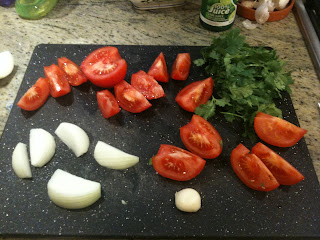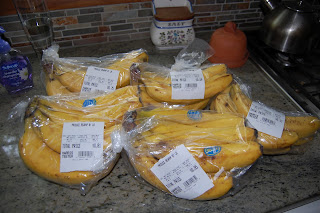It is so simple really and truly. Of course, like always, having the right tools make it easier, but you could even mix this by hand pretty quickly. There's a reason it's called quick bread!
The recipe below is for 3 loaves of bread. As always, I feel it's worth my effort to make bigger batches because it takes just as long (or about) to make 3 loaves as it does one, so why make just one?
On the day I actually made these, I made 6 loaves of this particular bread, but I did it in two batches as my mixer and blender couldn't handle bigger batches than that. My blender is a large vitamix blender and my mixer is a 6 quart Kitchen aid mixer (though from now on I think I'll use my 8 quart mixer - I really do like the Electrolux DLX mixer much better for almost everything).
The recipe is from "Baking Illustrated - the Practical Kitchen Companion for the Home Baker" by the editors of Cooks' Illustrated Magazine. I love this cookbook, by the way. If you want one really good baking cookbook with truly tried and true recipes, this book is more likely to hit the nail on the head than most other baking cookbooks - especially with the sheer volume of known/common recipes.
Of course, as always, I tweak it and make it easier for me, but you can stick to the recipe in the book if you prefer. This is how I did it:
Chocolate Banana Bread:
- 3 9x5 loaf pans
- 6 cups (30 ounces) unbleached all-purpose flour
- 3/4 cup unsweetened cocoa powder
- 2 1/4 cup granulated sugar
- 2 1/4 teaspoon baking soda
- 1 1/2 teaspoon salt
- 9 (approximately) ripe, soft, speckled large bananas, mashed well (4.5 cups mashed is a more accurate measure and what I use, instead of number of bananas. If you don't have enough bananas like short one or two, add a bit of applesauce to supplement to make up 4.5 cups total).
- 3/4 cup plain yogurt
- 18 tablespoons (2 sticks plus 2 tablespoons) unsalted butter, melted and cooled slightly - I put it in the microwave for 1 minute at 50% power and it comes out mostly melted with some very soft butter left unmelted.
- 3 teaspoons vanilla extract
In your mixer, mix together all the dry ingredients (flour, cocoa powder, sugar, baking soda, salt) like this:
Then, in your blender, first mash the bananas (liquify). I do it with 8-9 bananas first and then see if I need to add more to get to 4.5 cups total. Like this:

I then add all the rest of the liquid ingredients (eggs, yogurt, melted (mostly) butter and then whir it together:

I then add the liquids from the blender into the dry ingredients with the mixer and mix until just combined. I scrape it down and mix again and in the end. (As this mixer never seems to get the bottom, I mix a couple turns by hand.)
I then pour it evenly into the three loaf pans. It will fill the pan to about 2/3s. I first show it in my preferred loaf pans - metal. Glass is OK too.
But, since I made two batches of this, the second batch I used three different pans when I mixed up the next batch while this were baking. In this next batch, I had one of my preferred pans left, a glass pan and a silicone pan. The glass and silicone pans are my mother in laws which she had before moving in with us.
As I said, glass is OK, but silicone? I don't like silicone baking pans. Yes, they don't stick. Yes, they are light and easy, but they are too floppy and the bread will get a bit malformed, so it doesn't look as nice. You can see it a bit when it is ready to go in the oven:
But you can see even more after it's baked. See how it bulges at the sides?
And how they look when it's all done and is cooling:
I still had some bananas left over, so tomorrow, the banana blueberry bread which we love the most of all these banana breads:

















































